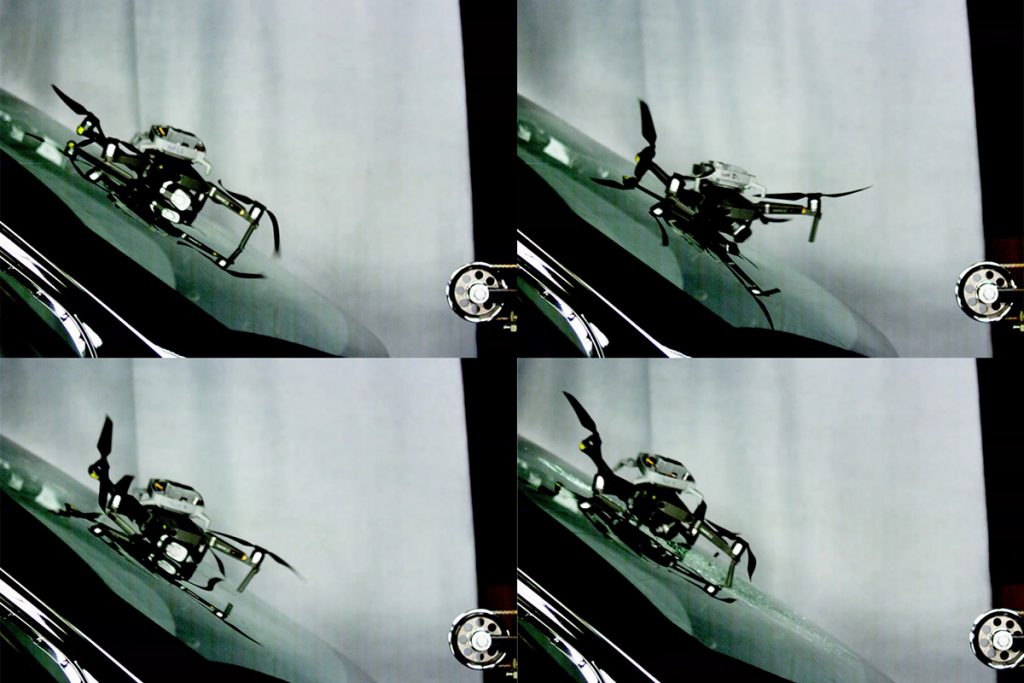
A drone slams into a windshield. The drone’s shell cracks, and the windshield shudders. Pieces of a propeller snap off. But the windshield doesn’t shatter.
Most safe drone flights aren’t supposed to end in crashes. But this crash is unfolding in one of Virginia Tech’s impact labs, where controlled collisions have been pivotal to producing safer cars, football helmets, and even toys. Here, collisions reveal information about risk and point to ways to reduce it. Now they’re helping lead to new ways to use drones.
For years, an important Federal Aviation Administration (FAA) regulation restricted commercial drone use in urban and suburban areas by prohibiting flying over moving vehicles. The concern was that a drone hitting the windshield of a moving car could obliterate the driver’s view of the road or, worse, injure the occupants.
Data demonstrating that a small parachute-equipped drone wouldn’t actually damage a car traveling at typical in-town speed limits provided a counterpoint to those concerns, one convincing enough to the FAA that it granted insurance company State Farm a waiver to operate drones over moving vehicles in 2019.
The data represent the first known example of direct research on drone-automobile collisions, a unique collaboration between drone specialists at the Virginia Tech Mid-Atlantic Aviation Partnership (MAAP), injury biomechanics experts in the university’s College of Engineering, and State Farm.
The waiver provided the company with an additional tool to use in processing homeowners insurance claims.
MAAP regularly collaborates with Virginia Tech’s acclaimed injury biomechanics researchers. The group, led by associate biomedical engineering and mechanics professor Steve Rowson, has earned international recognition for experimental methods that precisely recreate real-world collisions. These techniques offer a realistic and, crucially, reproducible way to quantify the risk of various impacts and evaluate the efficacy of safety measures.
The drone the team used was a DJI Mavic 2 Pro, a small aircraft that weighs just over 2 pounds. State Farm’s waiver application specified that during operations the drone would be equipped with a parachute from Israeli company ParaZero, technology that has been tested and has figured in multiple successful applications for waivers to fly over people. The researchers set out to replicate what might happen if, in the unlikely event of a catastrophic failure, the drone under the parachute was blown directly into the path of a moving vehicle.
They mounted the drone to a pneumatic sled that was propelled down a linear track toward a custom-built windshield frame that contained parts of a salvaged Toyota Camry. By varying the impact speed, which would translate to the speed of a moving vehicle in a real-world scenario, and assessing the damage, the team hoped to identify a threshold below which a drone could safely be flown overhead without risking a smashed windshield if something went wrong. They expected the degree of damage to the windshield to increase steadily as the impact speed rose.
Post-impact inspections showed a more interesting result. At impact speeds between 25 and 62.5 mph, the only signs of the collision were streaks of rubber and plastic transferred from the drone as it slid up the glass. When the Mavic hit at 67 miles per hour, a web of cracks shot across the windshield as it bowed inward, spitting shards of glass onto the floor.
The slim margin between a virtually pristine windshield and a destroyed one drew a clear boundary around low-risk scenarios. The waiver application argued that as long as potential relative impact speeds never exceeded 62 mph, flights over moving vehicles presented minimal risk. The FAA agreed.
— Eleanor Nelson




